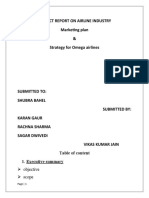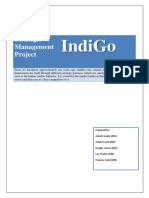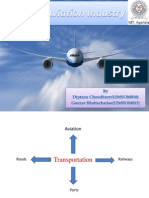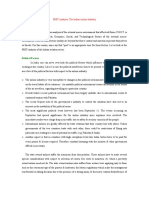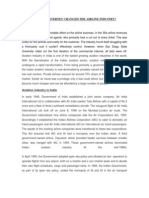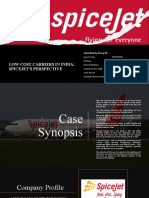December 2016 Examination DGM 02 Economic & Social Environment
December 2016 Examination DGM 02 Economic & Social Environment
Uploaded by
AmbrishCopyright:
Available Formats
December 2016 Examination DGM 02 Economic & Social Environment
December 2016 Examination DGM 02 Economic & Social Environment
Uploaded by
AmbrishOriginal Description:
Original Title
Copyright
Available Formats
Share this document
Did you find this document useful?
Is this content inappropriate?
Copyright:
Available Formats
December 2016 Examination DGM 02 Economic & Social Environment
December 2016 Examination DGM 02 Economic & Social Environment
Uploaded by
AmbrishCopyright:
Available Formats
DECEMBER 2016 EXAMINATION
DGM 02
ECONOMIC & SOCIAL ENVIRONMENT
Time: Three Hours Maximum Marks: 100
Note:
1. The paper is divided in TWO Sections: SECTION-A and SECTION-B.
2. There are five questions in SECTION-A. Students are required to attempt ANY THREE.
3. All the questions of SECTION-B (Case Study) are compulsory.
SECTION-A (20 Marks each)
1. How does the Internet affect Business Environment and the Globalization of the World
Economy?
2. Critically evaluate the demonetization of high denomination notes with their impact on Indian
economy?
3. Discuss the current Balance of Payments (BOP) scenario of Indian Economy. How does current
low export growth rate has affected Indian Medium and Small Scale Industries (MSME) sector?
4. Do you think introduction of ‘GST’ will help the business community in India? What are the
advantages of GST?
5. How increases in ‘Foreign Direct Investment’ (FDI) accelerate the economic Growth in India?
SECTION-B (40 Marks)
Case Study (Compulsory)
Privatisation of Airports and Airlines Industry
Privatisation of airports could lead to better operations and lower costs of aircraft carriers. All the
airports were fully owned by the government in India till recently. Under the new public-private
partnership scheme, more and more airports have been set up in semi urban India. The Cochin
International Airport was a project that was inaugurated in 1999, involving a partnership between the
government and the people (mainly NRIs), which functions outside the domain of the Airports Authority
of India. It has led to one of the most efficient airports in the country and mainly serves the huge
expatriate population travelling to and from Kerala. The company has made profit and broken even,
paying a dividend to its shareholders. This could be an ideal showcase project for future investments in
the airport sector?
DGM02/December 2016 Page 1/4
The competition among airports would allow airline operators to negotiate their landing prices, which
would be a great aid for low cost airlines in cutting their charges, as in the case of mature markets of the
west, which presented low cost airlines like Ryan-Air, Jet Blue (considered to be the hottest airlines in the
American Skies), South West Airlines and so on.
Similarly, the state-owned domestic and international carriers, the Indian Airlines and the Air India
dominated the airline market till recently in India. The air ticket prices were not affordable to ordinary
citizens. Although the government had plans to divest its stake in Air India and Indian Airlines initially, it
did not happen due to opposition from media and politicians. However, giving into the pressure of
liberalization, private airlines were allowed to operate in domestic routes as a first step. Due to the new
entrants like Jet Airways, the state-owned airlines started losing their market share as they lacked
technology upgradation and product offerings. Ministry of Civil Aviation in India has already adopted
many schemes for the growth and expansion of air transport. They have made new aviation policy,
which incorporated the construction of private sector airports, reconstruction of public sector airports
and purchase of new aircraft, which help the carriers to compete with the private players. The policy
would also accommodate to provide additional slots for foreign airlines at Indian airports and attract
foreign direct investment (FDI).
The Indian government has opened up their skies to the private Indian aircraft, which helps them to offer
their services internationally. As part of this policy, some of the private airlines are able to run
international flights. This ‘open skies policy’ and the entry of low cost carriers, have brought about a
boom like never before for the airline industry.
In general, the airlines industry has absolutely no control over some of the biggest expense heads
including fixed costs (in terms of leases and taxes) and variable costs (fuel and landing charges). Aviation
Turbine Fuel (ATF) constitutes close to 40% of an airline’s operating cost in India. This is almost twice that
of airlines in the West. The reason for high price of ATF in India is the huge customs and excise duty
levied on the fuel. Aviation turbine fuel is currently a monopoly of IOC (India Oil Corporation), BPCL
(Bharat Petroleum Corporation Ltd.), and HPCL (Hindustan Petroleum Corporation Ltd). The government
plans to allow private players to supply ATF, so that the completion in the market will help to reduce cost.
Although India boasts of more than 400 airports, just 62 of them are in active use, and Mumbai and
Delhi airports alone account for over 40% of the total air traffic in India. Traffic is growing both on major
routes (between metros) and ‘feeder routes’ (between smaller cities) within the country. The facilities at
Indian airports are woefully short. The poor infrastructure at Indian airports, including less space for
parking bays, maintenance hanger, check in counter space etc., is really pathetic. Two of the principles
of low-cost flying-quick turnarounds and increased aircraft utilization are very difficult to implement in
India because of the poor airport infrastructure. According to Ernest & Young industrial consultants,
India needs $10 billion (Rs. 44,000 crore) in investments to upgrade their airports.
Airports are an essential part of the air transport network. Consequently, the trend for privatising
airports is of importance to all stakeholders in the industry.
The key factor is that an airport can deliver the cost and service levels that airlines require, regardless of
the airport’s ownership structure. Therefore, where a decision is taken to privatise an airport, the
framework put in place must benefit both the industry and its customers. Privatising airports should not
be viewed simply as a short-term revenue raising option for governments. It must be seen as part of a
long-term vision for economic development.
DGM02/December 2016 Page 2/4
Investment in new airport capacity - along with more efficient usage of existing capacity - is essential if
the air transport industry is to meet future growth in demand in a sustainable way. A transparent
partnership between airlines and private sector or public sector airports is important if we are to meet
this challenge successfully.
KEY LESSONS FOR SUCCESSFUL AIRPORT PRIVATISATION
i. Customers as key stakeholders should be engaged from the outset and involved in an ongoing
and regular basis through agreed processes.
ii. A strong focus should be placed on achieving a more efficient management of the airport assets
through the transfer to private ownership.
iii. Good governance is extremely important if the privatisation is to be in the public interest.
iv. Independent, robust economic regulation is essential in order to create incentives for efficiency
improvements. Government interference in airport regulation automatically creates an
unacceptable conflict of interest.
v. The economic regulator should also be overseen by an independent Competition authority to
which airports and their customers have the right to appeal.
vi. Economic regulators have, so far, been more effective at extracting efficiencies from existing
assets rather than ensuring cost effectiveness from new investment.
vii. Mechanisms to incentivise cost efficiency must be built in to the process from the outset.
Regulation must avoid preserving monopoly profits or inefficiencies from the start.
viii. Service level agreements (or similar systems) must also be put in place to deliver a good quality
as well as a cost effective service.
ix. Controls must be put in place to prevent unjustified asset revaluations or regulatory structural
changes that burden airlines and their passengers with substantial charge increases.
x. Customer involvement in new investment is essential to ensure it is appropriate, cost effective
and delivered on time and on budget. The ‘gold plating’ of investment must be avoided.
Privatization helps more and more airports to spring up in India, which ultimately leads to better facilities
at airports. It helps to bring up more and more low-cost private airlines into this highly competitive field.
Reduction of import duties imposed, will help these airlines much, in lowering their fare also.
According to consultancy centre for Asia-Pacific Aviation (CAPA), domestic passenger traffic could grow
at a much faster rate in the coming years. By 2016, there could be 75 million Indians travelling by air,
resulting in an industry that’s Rs.50,000 crores according to CAPA. Indigo, a private Indian airlines, was
DGM02/December 2016 Page 3/4
able to draw more and more public attention by the introduction of their low-cost domestic airlines.
Indigo, Nusli Wadia’s (Bombay Dyeing) ‘Go Airline’, ‘Spice Jet’, ‘Royal Airways’, ‘Air India Express’…. thus
goes the long list of low-cost airlines. Most of the private airlines offer differentiated products and
competitive fares on first cum first serve basis, which has also worked as source for inspiration to public
sector airlines like Indian Airlines to reduce their prices.
6. Case Questions:
i. Do you think that privatization of airports would lead to more efficient management of
airport in India?
ii. Do you agree that privatizing airports should not be viewed simply as a short-term
revenue raising option for governments? It must be seen as part of a long-term vision
for economic development.
DGM02/December 2016 Page 4/4
You might also like
- National Cranberry CooperativeDocument11 pagesNational Cranberry CooperativeFabiola SE100% (2)
- (Volman) Understanding Price Action Practical Analysis of The 5-Minute Time Frame (Rasabourse - Com) - 46-90 - KopyaDocument45 pages(Volman) Understanding Price Action Practical Analysis of The 5-Minute Time Frame (Rasabourse - Com) - 46-90 - KopyaYokua100% (1)
- A Project Report On Airline IndustryDocument38 pagesA Project Report On Airline IndustrySagar Dwivedi60% (5)
- Pestel Analysis: Indigo AirlinesDocument10 pagesPestel Analysis: Indigo AirlinesVIRESH NANo ratings yet
- STP Strategy Analysis: SegmentationDocument8 pagesSTP Strategy Analysis: SegmentationAnkit KumarNo ratings yet
- Corporate Strategy PDFDocument27 pagesCorporate Strategy PDFaryan singhNo ratings yet
- CRM AIr IndiaDocument89 pagesCRM AIr IndiaPradeep Singhone80% (5)
- Indigo: Strategic Management ProjectDocument17 pagesIndigo: Strategic Management ProjectSumathi SrinivasNo ratings yet
- Nature AND Scope OF Business Economics: Chapter - 1Document64 pagesNature AND Scope OF Business Economics: Chapter - 1rajni rani100% (7)
- P RT: ADocument8 pagesP RT: ASachinNo ratings yet
- Air DeccanDocument8 pagesAir Deccanprateekbapna90No ratings yet
- Indian Aviation IndustryDocument7 pagesIndian Aviation IndustryAMAN KUMARNo ratings yet
- Industry Analysis Project IndigoDocument29 pagesIndustry Analysis Project IndigopurushottamNo ratings yet
- Industry Analysis Project (Indigo)Document30 pagesIndustry Analysis Project (Indigo)amar82% (11)
- PrefaceDocument52 pagesPrefacerck8687No ratings yet
- Aviation IdustryDocument40 pagesAviation IdustryGourav BhattacharjeeNo ratings yet
- C I B A P: Ndian ViationDocument3 pagesC I B A P: Ndian ViationEshan ShailendraNo ratings yet
- Vol 2 CH 8 Airport DFRDocument46 pagesVol 2 CH 8 Airport DFRSubhradeb PramanikNo ratings yet
- Research and Analysis of Indian AirlinesDocument48 pagesResearch and Analysis of Indian AirlinesArpana KarnaNo ratings yet
- Jet - EtihadDocument21 pagesJet - EtihadPooja KhandwalaNo ratings yet
- Akshay Gopal 07 Amit Jain 08 Ankur Arora 09 Ankur Dave 10 Anshul Rawat 11Document17 pagesAkshay Gopal 07 Amit Jain 08 Ankur Arora 09 Ankur Dave 10 Anshul Rawat 11Anshul RawatNo ratings yet
- Challenges of Indian Aviation Industry in Chaotic Phase: Rajesh U. KantheDocument3 pagesChallenges of Indian Aviation Industry in Chaotic Phase: Rajesh U. KanthePratham MittalNo ratings yet
- Air Law ProjectDocument21 pagesAir Law ProjectKamlakar ReddyNo ratings yet
- Business Policy - PESTLE Analysis of Aviation IndustryDocument6 pagesBusiness Policy - PESTLE Analysis of Aviation IndustryAbhishek Mishra100% (2)
- Airline Industry Service Sector ManagementDocument37 pagesAirline Industry Service Sector Managementharpreet_ladhadNo ratings yet
- Privatization in Indian AirlinesDocument12 pagesPrivatization in Indian AirlinesProf. R V SinghNo ratings yet
- Aviation Industry IndiaDocument16 pagesAviation Industry IndiaPandey NeetaNo ratings yet
- 25 Sectors For Make in India 2Document22 pages25 Sectors For Make in India 2sakuchandelNo ratings yet
- Low Cost Airline Case StudyDocument4 pagesLow Cost Airline Case StudyAnonymous uZw6hSvkuNo ratings yet
- Indian Aviation IndustryDocument12 pagesIndian Aviation Industrysreelakshmi sureshNo ratings yet
- Political Factors: PEST Analysis: The Indian Airline IndustryDocument27 pagesPolitical Factors: PEST Analysis: The Indian Airline IndustryPrasad Krishna ShivdasNo ratings yet
- Political Factors: PEST Analysis: The Indian Airline IndustryDocument27 pagesPolitical Factors: PEST Analysis: The Indian Airline Industrypooja_wavhalNo ratings yet
- Political Factors: PEST Analysis: The Indian Airline IndustryDocument27 pagesPolitical Factors: PEST Analysis: The Indian Airline Industrypooja_wavhalNo ratings yet
- Political Factors: PEST Analysis: The Indian Airline IndustryDocument27 pagesPolitical Factors: PEST Analysis: The Indian Airline Industryreddygaru1No ratings yet
- Research Papers On Indian Aviation IndustryDocument6 pagesResearch Papers On Indian Aviation Industryafmcsmvbr100% (1)
- Indigo Airlines ReportDocument20 pagesIndigo Airlines ReportMriganga Barman100% (1)
- Final Analysis On Aviation Sector in IndiaDocument29 pagesFinal Analysis On Aviation Sector in IndiaKinchit PandyaNo ratings yet
- How Has Internet Changed The Airline Industry (Itb Projrct)Document11 pagesHow Has Internet Changed The Airline Industry (Itb Projrct)Sadaf Zuberi50% (2)
- Indian Airlines: 7P'S, Strategies & RecommendationsDocument44 pagesIndian Airlines: 7P'S, Strategies & RecommendationsBhanu MehraNo ratings yet
- Strategic Analysis of Air India ExpressDocument6 pagesStrategic Analysis of Air India ExpressGia TrungNo ratings yet
- Me C3 Group 7Document13 pagesMe C3 Group 7SARTHAK BISTNo ratings yet
- APAO Presentation 26 March 2013Document26 pagesAPAO Presentation 26 March 2013Shanmukh GollapudiNo ratings yet
- Research and Analysis of The Indian Aviation IndustryDocument20 pagesResearch and Analysis of The Indian Aviation IndustryNikhil ReddyNo ratings yet
- Open Sky Di IndiaDocument8 pagesOpen Sky Di IndiaDila NoorNo ratings yet
- Aviation Industry PESTLEDocument8 pagesAviation Industry PESTLEAnish GuptaNo ratings yet
- Research Report On JET AIRWAYSDocument21 pagesResearch Report On JET AIRWAYSViniti Dhar100% (5)
- Future of Work in Aviation Industry Concept PaperDocument8 pagesFuture of Work in Aviation Industry Concept PaperPalak Makhija100% (1)
- Special Report - Putting The Pieces TogetherDocument5 pagesSpecial Report - Putting The Pieces TogetherRonit GuptaNo ratings yet
- IndigoDocument25 pagesIndigoprabodh20100% (1)
- Indian Aviation Sector Political Factors: PESTEL AnalysisDocument3 pagesIndian Aviation Sector Political Factors: PESTEL AnalysisAatish PanditNo ratings yet
- Privatisation of Airports in IndiaDocument21 pagesPrivatisation of Airports in IndiaprincechennaiNo ratings yet
- Industry Analysis of Airline Industry in IndiaDocument13 pagesIndustry Analysis of Airline Industry in IndiaVivek KumarNo ratings yet
- Group B7 - SM - LOW-COST CARRIERS IN INDIA-Spicejet's PerspectiveDocument11 pagesGroup B7 - SM - LOW-COST CARRIERS IN INDIA-Spicejet's PerspectiveAyush100% (1)
- Indigo AirlineDocument23 pagesIndigo AirlineSayali DiwateNo ratings yet
- A PEST Analysis Is An Analysis of Airline IndustryDocument5 pagesA PEST Analysis Is An Analysis of Airline Industryerohu123456100% (1)
- Strategic Management Report: Student Id: 21420599 Submitted To: MS. Sneha ThakkarDocument13 pagesStrategic Management Report: Student Id: 21420599 Submitted To: MS. Sneha ThakkarRohan KurupNo ratings yet
- Term Paper On Strategic Management Topic Strategies Followed by Low-Cost Airline-IndigoDocument25 pagesTerm Paper On Strategic Management Topic Strategies Followed by Low-Cost Airline-Indigoroshansorly50% (2)
- National Civil Aviation PolicyDocument6 pagesNational Civil Aviation PolicyMd Sarfaraz NawazNo ratings yet
- Aviation Industry Project@āмĭтDocument53 pagesAviation Industry Project@āмĭтAmit DubeyNo ratings yet
- Policies to Support the Development of Indonesia’s Manufacturing Sector during 2020–2024: A Joint ADB–BAPPENAS ReportFrom EverandPolicies to Support the Development of Indonesia’s Manufacturing Sector during 2020–2024: A Joint ADB–BAPPENAS ReportNo ratings yet
- Leveraging on India: Best Practices Related to Manufacturing, Engineering, and ItFrom EverandLeveraging on India: Best Practices Related to Manufacturing, Engineering, and ItNo ratings yet
- Innovation in Aviation - A Case Study of United AirlinesFrom EverandInnovation in Aviation - A Case Study of United AirlinesNo ratings yet
- Solid Slab Bridges: Advantages, Disadvantages and PrinciplesDocument10 pagesSolid Slab Bridges: Advantages, Disadvantages and PrinciplesAmbrishNo ratings yet
- New Safety Reporting Proposals Have Your SayDocument3 pagesNew Safety Reporting Proposals Have Your SayAmbrishNo ratings yet
- Travel Ideas-AKDocument31 pagesTravel Ideas-AKAmbrishNo ratings yet
- Who Are Shiro and Marilyn?: Photo by Jaclynn Seah Via The Occasional TravellerDocument3 pagesWho Are Shiro and Marilyn?: Photo by Jaclynn Seah Via The Occasional TravellerAmbrishNo ratings yet
- K-69 A, Basement, Kalkaji, New Delhi 110019Document1 pageK-69 A, Basement, Kalkaji, New Delhi 110019AmbrishNo ratings yet
- 2016 Midas Civil FAQDocument3 pages2016 Midas Civil FAQAmbrishNo ratings yet
- 23m Pot Ptfe DetailsDocument10 pages23m Pot Ptfe DetailsAmbrishNo ratings yet
- Hyperstatic PDFDocument5 pagesHyperstatic PDFAmbrishNo ratings yet
- 12 Ub DN 6502 (C)Document59 pages12 Ub DN 6502 (C)AmbrishNo ratings yet
- Introducing Sharing Links: What Is The Difference Between Shuttering and Centring of Concrete?Document7 pagesIntroducing Sharing Links: What Is The Difference Between Shuttering and Centring of Concrete?AmbrishNo ratings yet
- Question PaperDocument3 pagesQuestion PaperAmbrishNo ratings yet
- Master's Thesis - Final DraftDocument288 pagesMaster's Thesis - Final DraftAmbrishNo ratings yet
- Chapter 5 - The Standard Trade ModelDocument7 pagesChapter 5 - The Standard Trade ModelResha DayaoNo ratings yet
- ACCT1501 Perdisco Adjusting EntriesDocument16 pagesACCT1501 Perdisco Adjusting Entriesloz9993% (57)
- NSS Exploring Economics 1 (3 Edition) : Revision NotesDocument4 pagesNSS Exploring Economics 1 (3 Edition) : Revision Notesrrrrr88888No ratings yet
- Rothenberger Marketing Boot Camp 09102023Document23 pagesRothenberger Marketing Boot Camp 09102023mathieu652540No ratings yet
- HANDOUTS Notes FIMDFINADocument13 pagesHANDOUTS Notes FIMDFINAmilanomenganNo ratings yet
- Letter of Credit ExplainedDocument20 pagesLetter of Credit ExplainedSushant Verma100% (1)
- Ifrs 15Document75 pagesIfrs 15Hồ Đan ThụcNo ratings yet
- Accounting For CorporationsDocument6 pagesAccounting For Corporationsmaine pamintuanNo ratings yet
- Women's Care Center Opens in East HoustonDocument8 pagesWomen's Care Center Opens in East HoustonAnonymous 2SN9zjvNo ratings yet
- 07 Quiz 1Document2 pages07 Quiz 1Von Marvic PonceNo ratings yet
- Furniture ProductionDocument25 pagesFurniture ProductionMisge Chekole100% (1)
- Golden State Home Health Inc Is A Large California Based For ProfitDocument3 pagesGolden State Home Health Inc Is A Large California Based For ProfitDoreen0% (1)
- The Concept of Core Competency: Indian Institute of Technology RoparDocument24 pagesThe Concept of Core Competency: Indian Institute of Technology RoparSubrat RathNo ratings yet
- Issue of Debentures - Class WorkDocument4 pagesIssue of Debentures - Class Worklalitha sureshNo ratings yet
- Income Tax 2nd Quiz PrelimDocument5 pagesIncome Tax 2nd Quiz PrelimRenalyn ParasNo ratings yet
- Mercado V Valley Mountain Case DigestDocument2 pagesMercado V Valley Mountain Case DigesthistabNo ratings yet
- TD SystemDocument23 pagesTD Systemmoluguru100% (2)
- Money Times Dec5Document22 pagesMoney Times Dec5Rajesh KumarNo ratings yet
- Economics Optional StrategyDocument15 pagesEconomics Optional StrategySuraj KumarNo ratings yet
- Money Markets: Financial Markets and Institutions, 7e, Jeff MaduraDocument44 pagesMoney Markets: Financial Markets and Institutions, 7e, Jeff MaduraMuntazir HussainNo ratings yet
- FSAP ManualDocument7 pagesFSAP ManualJose ArmazaNo ratings yet
- Salvatore's International Economics - 10 Edition Instructor's ManualDocument5 pagesSalvatore's International Economics - 10 Edition Instructor's Manualhoàng trương việtNo ratings yet
- Oil & Gas ManagementDocument36 pagesOil & Gas Managementmagsuarez1100% (3)
- 7110 w13 Ms 22Document10 pages7110 w13 Ms 22Muhammad UmairNo ratings yet
- Sandeep Garg Questions Class 12Document5 pagesSandeep Garg Questions Class 12nikhil070407mehtaNo ratings yet
- MC 206 FDocument18 pagesMC 206 Fthella deva prasadNo ratings yet
- Stock MarketDocument28 pagesStock MarketAmit PoddarNo ratings yet


